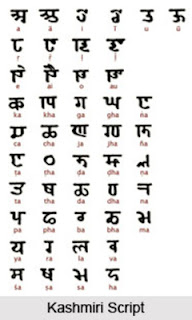Kashmiri script is a fascinating subject that
encapsulates the rich cultural and historical tapestry of the Kashmir Valley.
Historically, the Kashmir Valley, renowned for its picturesque landscapes and
cultural richness, has also been a melting pot of various linguistic and
scriptural influences. The script used to write the Kashmiri language reflects
this diversity and evolution.
The Kashmiri language, a
member of the Dardic group of Indo-Aryan languages, has been historically
written in several scripts. Each script not only represents a phase in the
language’s development but also reveals a lot about the socio-political
influences of its time.
Initially, Kashmiris used the Sharada script, an
ancient Brahmic script. Sharada, which emerged around the 8th century CE, was
widely used for religious and literary works. It is a direct descendant of the
Gupta script and bears a close resemblance to the Devanagari script used for
Sanskrit. The script’s structure is a testament to the region's historical
connectivity with the broader Indian cultural and linguistic milieu.
By the 14th century, during the Sultanate period,
the Persian influence began to permeate Kashmir, a shift that had a profound
impact on the script used for Kashmiri. The Persian script, an adaptation of
the Arabic script, became increasingly popular due to its association with the
Islamic administration and culture that prevailed under Sultan Sikandar and his
successors. This shift was reflective of the changing political and cultural
landscape of Kashmir.
Despite the adoption of the Persian script, the Sharada
script did not disappear entirely. It continued to be used by scholars and for
religious purposes, maintaining its presence alongside the more dominant
Persian script. This coexistence of scripts highlighted the region's cultural
pluralism.
In contemporary times, the Kashmiri
language has also been transcribed using the Roman script, particularly in
informal contexts such as social media and online communication. This
development represents the influence of globalization and the need for a more
accessible means of communication in a digital age.
Efforts have been made to revive the Sharada script
in recent years. The Sharada Academy, established in Jammu and Kashmir, is at
the forefront of these efforts. The revival is part of a broader movement to
preserve and promote the historical and cultural heritage of the region.
Scholars and enthusiasts have been working to bring this ancient script back
into use, with educational programs and publications aimed at familiarizing the
younger generation with Sharada.
The Kashmiri language itself is a rich repository
of the region’s folklore, poetry, and traditions. The scripts used to write it
offer a glimpse into the evolving identity of the Kashmiri people. They are not
merely tools for communication but are emblematic of the socio-political and
cultural transformations that have shaped the region.
In conclusion, the Kashmiri
script is more than just a means of writing; it is a window into the historical
and cultural evolution of the Kashmir Valley. From its origins in Sharada to
its modern adaptations, the script reflects the rich and diverse tapestry of
Kashmir’s heritage. The ongoing efforts to revive and preserve these scripts
underscore their importance in maintaining the cultural identity of the
Kashmiri people.
